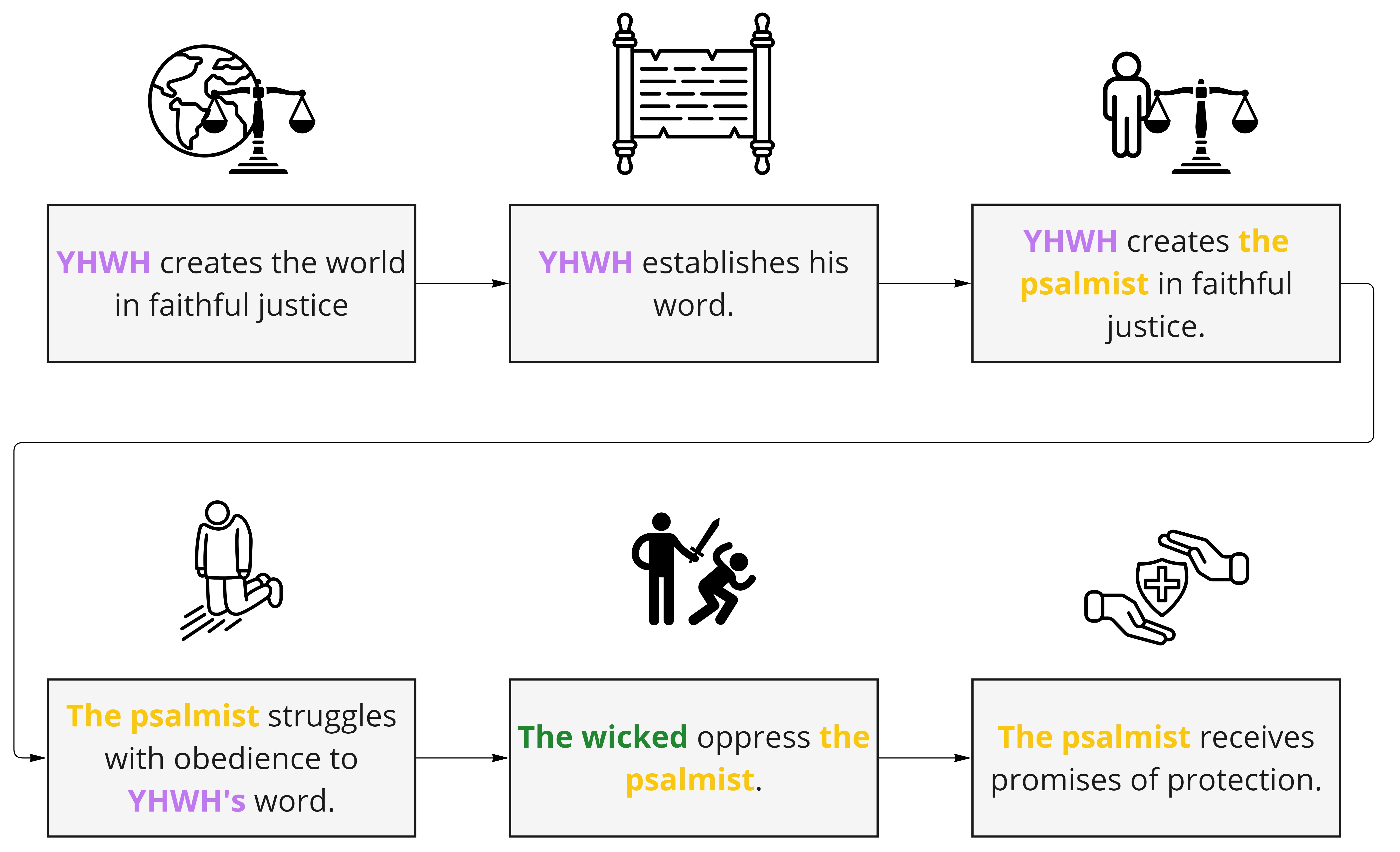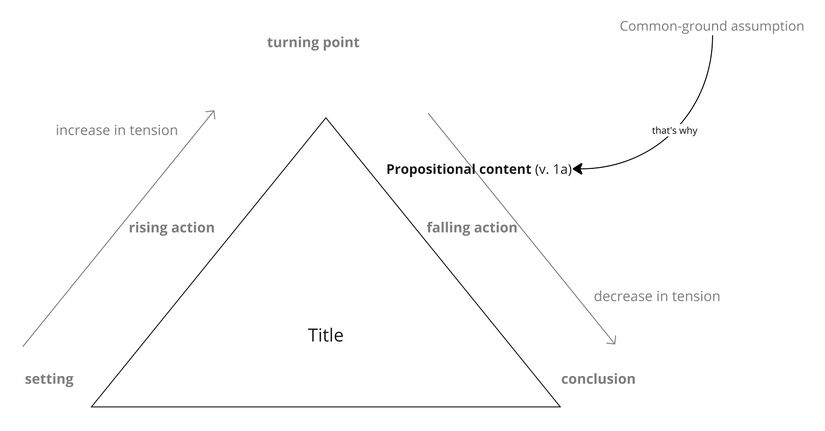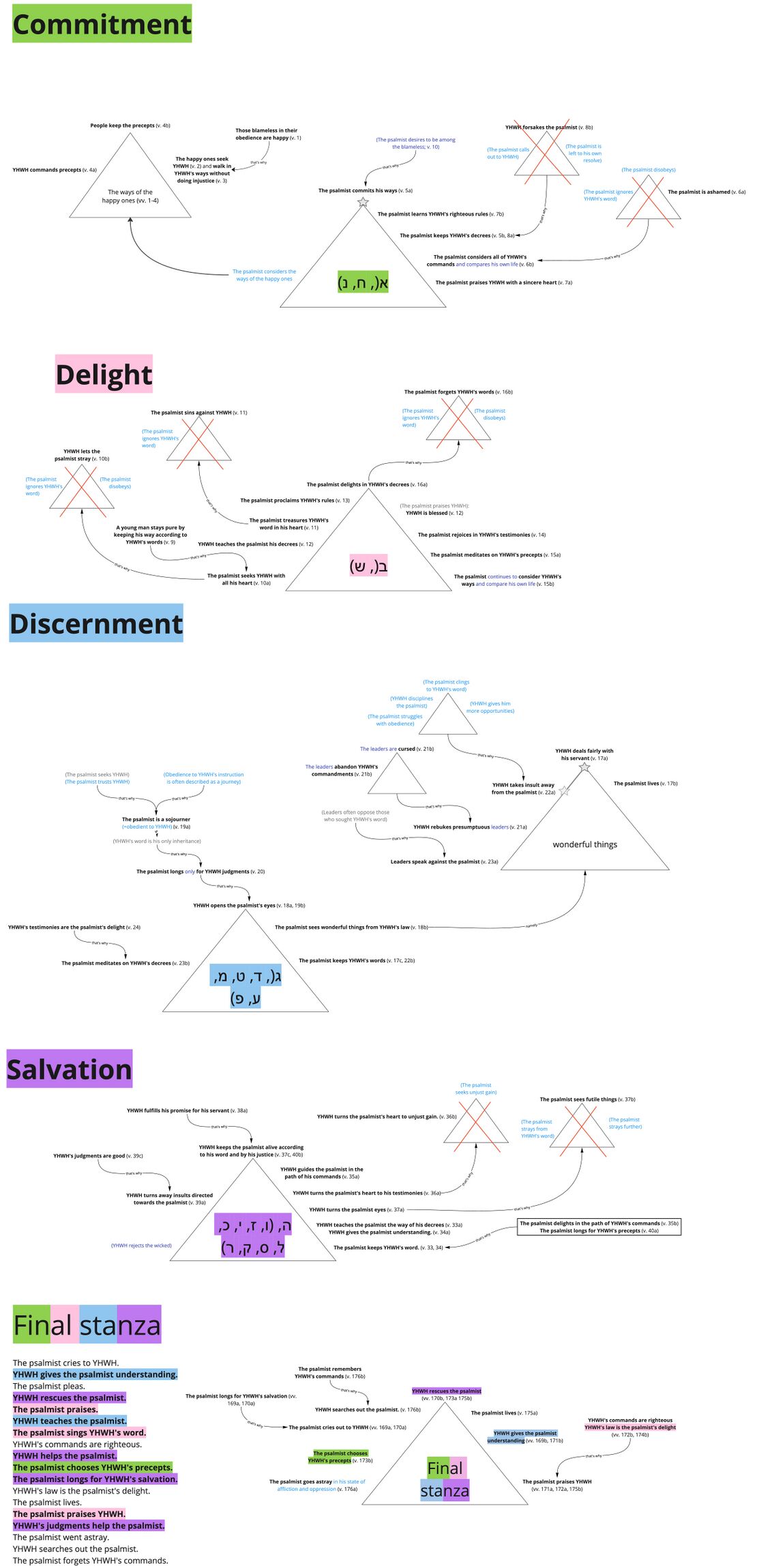Psalm 119 Story Behind
About the Story Behind Layer
The Story Behind the Psalm shows how each part of the psalm fits together into a single coherent whole. Whereas most semantic analysis focuses on discrete parts of a text such as the meaning of a word or phrase, Story Behind the Psalm considers the meaning of larger units of discourse, including the entire psalm.
The goal of this layer is to reconstruct and visualise a mental representation of the text as the earliest hearers/readers might have conceptualised it. We start by identifying the propositional content of each clause in the psalm, and then we identify relevant assumptions implied by each of the propositions. During this process, we also identify and analyse metaphorical language (“imagery”). Finally, we try to see how all of the propositions and assumptions fit together to form a coherent mental representation. The main tool we use for structuring the propositions and assumptions is a story triangle, which visualises the rise and fall of tension within a semantic unit. Although story triangles are traditionally used to analyse stories in the literary sense of the word, we use them at this layer to analyse “stories” in the cognitive sense of the word—i.e., a story as a sequence of propositions and assumptions that has tension.
Summary Triangle
The story triangle below summarises the story of the whole psalm. We use the same colour scheme as in Participant Analysis. The star icon along the edge of the story-triangle indicates the point of the story in which the psalm itself (as a speech event) takes place. We also include a theme at the bottom of the story. The theme is the main message conveyed by the story-behind.
| Story Triangles legend | |
|---|---|
| Propositional content (verse number) | Propositional content, the base meaning of the clause, is indicated by bold black text. The verse number immediately follows the correlating proposition in black text inside parentheses. |
| Common-ground assumption | Common-ground assumptions[1] are indicated by gray text. |
| Local-ground assumption | Local-ground assumptions[2] are indicated by dark blue text. |
| Playground assumption | Playground assumptions[3] are indicated by light blue text. |
| The point of the story at which the psalm takes place (as a speech event) is indicated by a gray star. | |
| If applicable, the point of the story at which the psalm BEGINS to take place (as a speech event) is indicated with a light gray star. A gray arrow will travel from this star to the point at which the psalm ends, indicated by the darker gray star. | |
| A story that repeats is indicated by a circular arrow. This indicates a sequence of either habitual or iterative events. | |
| A story or event that does not happen or the psalmist does not wish to happen is indicated with a red X over the story triangle. | |
| Connections between propositions and/or assumptions are indicated by black arrows with small text indicating how the ideas are connected. | |
| Note: In the Summary triangle, highlight color scheme follows the colors of participant analysis. | |
Background ideas
Following are the common-ground assumptionsCommon-ground assumptions include information shared by the speaker and hearers. In our analysis, we mainly use this category for Biblical/Ancient Near Eastern background. which are the most helpful for making sense of the psalm.
- YHWH disciplines those he loves (Deut 8:5; 2 Sam 7:14; Jer 30:11; 31:18-20; Prov 3:12; Ps 32:3-5; 94:12).
- The instrument of his discipline will not go unpunished (Jer 30:11, 16; Hab 3:1-16).
- The same authority expressed when YHWH established his creation is the authority expressed when YHWH established his word (Ps 24:1-2; 119:152).
- YHWH's enduring faithfulness to his creation implicates his enduring faithfulness to his people (Gen 8:22; Jer 31:36; Ps 96:10).
- As a metonymical extension, devotion to YHWH's word amounts to devotion to YHWH himself (Reynolds 2010, 34ff., Procházková 2021, 81; see also Isa 42:21, Ps 97:8).
- Obedience to YHWH's word is impossible without YHWH's help (Jer 32:39-40; Ezek 36:24-28).
- An ingathering of kings will seek and learn YHWH's word (Isa 2:1-4; 60:3; Ps 2:10-12; Ps 102:19-23; Ps 148:11 and especially Ps 138:1-5).
Background situation
The background situation is the series of events leading up to the time in which the psalm is spoken. These are taken from the story triangle – whatever lies to the left of the star icon.

Expanded Paraphrase
The expanded paraphrase seeks to capture the implicit information within the text and make it explicit for readers today. It is based on the CBC translation and uses italic text to provide the most salient background information, presuppositions, entailments, and inferences.
| Expanded paraphrase legend | |
|---|---|
| Close but Clear (CBC) translation | The CBC, our close but clear translation of the Hebrew, is represented in bold text. |
| Assumptions | Assumptions which provide background information, presuppositions, entailments, and inferences are represented in italics. |
There are currently no Imagery Tables available for this psalm.
Bibliography
- Allen, Leslie, C. 2002. Psalms 101-150. Nashville, TN: Thomas Nelson.
- Amir, Yehoshua. 1985. "Psalm 119 als Zeugnis eines protorabbinischen Judentums." In Yehoshua Amir (ed.) Studien zum Antiken Judentum. Frankfurt & New York: Peter Lang.
- Atkinson, Ian. Forthcoming 2025. "Bipartite Verbless Clauses." In Geoffrey Khan (ed.) The Cambridge Grammar of Biblical Hebrew. Cambridge: University of Cambridge & Open Book Publishers.
- Auffret, P. 1993. Voyez de Voz Yeux: Étude Structurelle de Vingt Psaumes dont le Psaume 119. Leiden: Brill.
- Auffret, P. 2006. Mais Tu Élargirais mon Cœur: Nouvelle Étude Structurelle du Psaume 119. Berlin: Walter de Gruyter.
- Barthélemy, Dominique. 2005. Critique Textuelle de l'Ancien Testament: Tome 4. Psaumes. Fribourg/Göttingen: Vandenhoeck Ruprecht.
- BDB = Brown, Francis, Driver, Samuel R. & Briggs, Charles A. 1977. Brown-Driver-Briggs Hebrew and English Lexicon. Oxford: Clarendon Press.
- Beentjes, P. C. 1997. The Book of Ben Sira in Hebrew: A Text Edition of all Extant Hebrew Manuscripts and a Synopsis of all Parallel Hebrew Ben Sira Texts. Leiden: Brill.
- BHRG = Van der Merwe, C. H. J., Naudé, J. A., Kroeze, J. H. 2017. A Biblical Hebrew Reference Grammar. London: Bloomsbury T&T Clark.
- Bratcher, Robert G. & Reyburn, William, D. 1991. A Translator’s Handbook on the Book of Psalms, UBS Handbook Series. New York, NY: United Bible Societies.
- Bridge, Edward, J. 2009. "Loyalty, Dependency and Status with YHWH: The Use of ʿbd in the Psalms." VT 59, no. 3: 360-378.
- CAD = Roth, Martha, T (ed.). 1956-2010. The Assyrian Dictionary of the Oriental Institute of the University of Chicago. Chicago, IL: Oriental Institute.
- CAL = Kaufman, Stephen A. (ed.). The Comprehensive Aramaic Lexicon.
- CGL = Diggle, James (ed.). 2021. The Cambridge Greek Lexicon. Cambridge: Cambridge University Press.
- Croft, W. 2022. Morphosyntax: Constructions of the World's Languages. Cambridge: Cambridge University Press.
- DCH = David J. A. Clines, David J. A. (ed). 1993-2011. The Dictionary of Classical Hebrew. Sheffield: Sheffield Academic Press.
- DeClaisse-Walford, Nancy in DeClaisse-Walford, Nancy et al. 2014. The Book of Psalms. Grand Rapids, MI: Eerdmans.
- Deissler, Alfons. 1955. Psalm 119 (118) und seine Theologie. Munich: Karl Zink Verlag.
- De-Rossi, Giovanni B. 2012 (1784). Variae Lectiones Veteris Testamenti, Vol. IV. Piscataway, NJ: Gorgias Press.
- Elwolde, John F. 1997. "Some Lexical Structures in 1QH: Towards a Distinction of the Linguistic and the Literary." Pages 77-116 in Takamitsu Muraoka & John F. Elwolde (eds.) Sirach, Scrolls, and Sages: Proceedings of a Second International Symposium on the Hebrew of the Dead Sea Scrolls, Ben Sira, and the Mishnah, Held at Leiden University, 15-17 December 1997. Leiden: Brill.
- Eusebius von Caesarea, Werke Band X der Psalmenkommentar, Teil 3: Fragmente zu Psalm 101-150. Franz X. Risch (ed.). Berlin: De Gruyter, 2022.
- Fassberg, Steven E. 2019. An Introduction to the Syntax of Biblical Hebrew (in Hebrew). Jerusalem: The Bialik Institute.
- Firth, J. 2023. "The Suffering Servant in Book V of the Psalter." Pages 111-126 in Reading the Psalms Theologically. Edited by D. M. Howard Jr. & A. J. Schmutzer. Bellingham, WA: Lexham Academic Press.
- Fokkelman, J. P. 2003. Major Poems of the Hebrew Bible: at the Interface of Prosody and Structural Analysis. Vol. III: The Remaining 65 Psalms. Assen: Royal van Gorcum, 235-270.
- Freedman, David N. 1999. Psalm 119: The Exaltation of Torah. Winona Lake, IN: Eisenbrauns.
- Gesenius = Gesenius, W. Donner, H. Rüterswörden, U. Renz, J. Meyer, R. (eds.). 2013. Hebräisches und aramäisches Handwörterbuch über das Alte Testament. 18. Auflage Gesamtausgabe. Berlin: Springer.
- GKC = Gesenius, Wilhelm & Kautsch, Emil. 1909. A. E. Cowley (trans.) Gesenius' Hebrew Grammar. Oxford: Clarendon Press.
- Goldingay, John. 2008. Psalms 90-150. Grand Rapids, MI: Baker Academic.
- Grosser, Emmylou, J. 2023. Unparalleled Poetry. Oxford: Oxford University Press.
- Ḥakham, Amos. 1979. ספר תהלים: ספרים ג–ה (in Hebrew; The Book of Psalms: Books 3-5). Jerusalem: Mossad Harav Kook.
- HALOT = Ludwig Koehler, Ludwig & Baumgartner, Walter et al. 1994-2000. The Hebrew and Aramaic Lexicon of the Old Testament. Leiden: Brill.
- Hardy, H. H. II. 2022. The Development of Biblical Hebrew Prepositions. Atlanta, GA: SBL Press.
- Harper's = E. A. Andrews, C. T. Lewis, C. Short. 1879. Harper's Latin Dictionary: A New Latin Dictionary Founded on the Translation of Freund's Latin-German Lexicon. Oxford: Clarendon Press.
- Hoftijzer, J, Jongeling, K 1995. Dictionary of the North-West Semitic Inscriptions. Leiden: Brill.
- Hurvitz, Avi. 1972. בין לשון ללשון: לתולדות לשון המקרא בימי בית שני (in Hebrew; The Transition Period in Biblical Hebrew: A Study in Post-Exilic Hebrew and its Implications for the Dating of Psalms). Jerusalem: Bialik Institute.
- ________. 1988. Wisdom Vocabulary in the Hebrew Psalter: A Contribution to the Study of "Wisdom Psalms." VT 38, no. 1: 41-51.
- Ibn Ezra, Abraham on Psalms.
- James, E. T. 2022. "The Asethetics of Biblical Acrostics." Pages 319-339 in JSOT 46(3).
- Jastrow, Marcus. 1903. A Dictionary of the Targumim, the Talmud Babli and Yerushalmi, and the Midrashic Literature. London: W.C. Luzac & Co.
- Jenni, Ernst. 1992. Die Hebräischen Präpositionen Band 1: Die Präposition Beth. Stuttgart: Verlag W. Kohlhammer.
- ________. 2000. Die Hebräischen Präpositionen Band 3: Die Präposition Lamed. Stuttgart: Verlag W. Kohlhammer.
- Joüon, Paul & Muraoka, Takamitsu. 2006. A Grammar of Biblical Hebrew. Rome: Pontificio Istituto Biblico.
- Keel, Othmar. 1997. The Symbolism of the Biblical World: Ancient Near Eastern Iconography and the Book of Psalms. Leiden: Brill.
- Kim, Young Bok. 2022. Hebrew Forms of Address: A Sociolinguistic Analysis. PhD Dissertation, University of Chicago.
- Kraus, H. J. 1989. Psalms 60-150: A Commentary (trans.) H. C. Oswald. Minneapolis, MN: Fortress Press.
- Lane, Edward, W. An Arabic-English Lexicon.
- LSJ = Liddel, Henry G., Scott, R. & Jones, Henry, S. 1996. A Greek-English Lexicon. Oxford: Clarendon Press.
- Mays, J. L. 1987. "The Place of the Torah-Psalms in the Psalter." JBL 106, no, 1: 3-12.
- Mena, Andrea, K. 2012. The Semantic Potential of עַל in Genesis, Psalms, and Chronicles. MA Thesis, University of Stellenbosch.
- Miller, Cynthia. 2010. Vocative Syntax in Biblical Hebrew Prose and Poetry: A Preliminary Analysis. Semitic Studies 55, no.1: 347-364.
- Muraoka, T. 2016. A Syntax of Septuagint Greek. Leuven: Peeters.
- NIDOTTE = VanGemeren, Willem (ed.). 1997. New International Dictionary of Old Testament Theology & Exegesis. Grand Rapids, MI: Zondervan.
- Notarius, Tania & Atkinson, Ian. Forthcoming 2025. "Impersonal Constructions." In Geoffrey Khan (ed.) The Cambridge Grammar of Biblical Hebrew. Cambridge: University of Cambridge & Open Book Publishers.
- Del Olmo Lete, G, Sanmartín, J, Watson, W. G. E. (trans.) 2015. A Dictionary of the Ugaritic Language in the Alphabetic Tradition. Leiden: Brill.
- Parry, Donald W., & Andrew C. Skinner eds., Dead Sea Scrolls Electronic Library Biblical Texts. In Consultation with Emanuel Tov and Eugene Ulrich. Leiden: Brill, 2015, http://dx.doi.org/10.1163/2451-9383_dss.11q5.dsbo-eng2
- Penney, Jason. 2023. A Typological Examination of the Pluractionality in the Biblical Hebrew Piel. MA Thesis, Dallas International University.
- Procházková, Ivana. 2021. The Torah / Law is a Journey: Using Cognitive and Culturally Oriented Linguistics to Interpret and Translate Metaphors in the Hebrew Bible. Prague: Karolinum Press.
- RADAK, Sefer HaShorashim.
- Rashi (Yitzchaki, Shlomo) on Psalms.
- Revell, Ernst J. 2004. A List of Pausal Forms in the TeNaK. The Pericope Group.
- Reynolds, Kent. 2008. "The Answer of Psalm CXIX 9." VT 58, no. 2: 265-269.
- ________. 2010. Torah as Teacher: The Exemplary Torah Student in Psalm 119. Leiden: Brill.
- Ringleben, Joachim. "Das Wort, Die Weg, und die Weisung: Systematische Analyse von Psalm 119." Kerygma und Dogma 65: 173-201.
- SDBH = de Blois, Reinier (ed.). Semantic Dictionary of Biblical Hebrew. United Bible Societies.
- Schipper, Bernd. U. 2014. “Egyptian Backgrounds to the Psalms.” Pages 57-75 in William P. Brown (ed.) The Oxford Handbook of the Psalms. Oxford: Oxford University Press.
- Sjörs, Ambjörn. 2018. Historical Aspects of Standard Negation in Semitic. Leiden: Brill.
- ________. Forthcoming 2025. "Infinitive Construct." In Geoffrey Khan (ed.) The Cambridge Grammar of Biblical Hebrew. Cambridge: University of Cambridge & Open Book Publishers.
- Sokoloff, Michael. 2009. A Syriac Lexicon: A Translation from the Latin, Correction, Expansion, and Update of C. Brockelmann's Lexicon Syriacum. Winona Lake, IN: Eisenbrauns & Piscataway, NJ: Gorgias Press.
- ________. 2017. A Dictionary of Jewish Palestinian Aramaic of the Byzantine Period. Ramat Gan: Bar-Ilan University Press.
- Soll, Will. 1987. "The Question of Psalm 119:9." JBL 106, no. 4: 687-688.
- ________. 1991. Psalm 119: Matrix, Form and Setting. Washington, DC: Catholic Biblical Association of America.
- Stec, David M. 2004. The Targum of Psalms: Translated, with a Critical Introduction, Apparatus, and Notes. Collegeville, MN: Liturgical Press.
- Talmy, Leonard. 2000. Toward A Cognitive Semantics: Concept Structuring Systems. Cambridge, MA: MIT Press.
- Taylor, Richard A. in Bali, Joseph & George Kiraz (eds.). 2020. The Psalms According to the Syriac Peshitta Version with English Translation. Piscataway, NJ: Gorgias Press.
- TDOT = Botterweck, G. Johannes & Ringgren, Helmer (eds.). 1978. Theological Dictionary of the Old Testament, Volume III. Grand Rapids, MI: Eerdmans.
- Terrien, Samuel. 2003. The Psalms: Strophic Structure and Theological Commentary. Grand Rapids, MI: Eerdmans.
- Tigay, Jeffrey H. 2017. "On the Tolerative/Permissive Hiph῾il." Pages 397-414 in F. E. Greenspahn & G. A. Rendsburg (eds.) Le-ma‘an Ziony: Essays in Honor of Ziony Zevit. Eugene, OR: Cascade Books.
- TLOT = Jenni, Ernst & Westermann, Claus (eds.). 1997. Theological Lexicon of the Old Testament, Volumes I-III. Trans. Mark E. Biddle. Peabody, MA: Hendrickson.
- van der Lugt, P. 2013. Cantos and Strophes in Biblical Hebrew Poetry III: Psalms 90-150 and Psalm 1. Leiden: Brill.
- van der Merwe, C. H. J. 2009. "Another Look at the Biblical Hebrew Focus Particle גַּם." JSS 54, no. 2: 313-332.
- ________. 2023. "The Conceptualization of Heart as an Active Zone Body Part in Biblical Hebrew." Pages 294-318 in Hanneke van Loon and Pierre van Hecke (eds.) Where Is the Way to the Dwelling of Light? Studies in Genesis, Job and Linguistics in Honor of Ellen van Wolde. Leiden: Brill.
- VTH = Benjamin Kennicott (ed.). 1776. Vetus Testamentum Hebraicum: cum variis lectionibus. Oxford: Clarendon Press.
- Warren-Rothlin, Andy. "Idioms: Biblical Hebrew." Pages 227-229 in Encyclopedia of Hebrew Language and Linguistics, Volume 2. Edited by G. Khan. Leiden: Brill.
- Weitzman, M. P. 1999. The Syriac Version of the Old Testament: An Introduction. Cambridge: Cambridge University Press.
- Whybray, Roger. N. 1997. "Psalm 119: Profile of a Psalmist." Pages 31-43 in Wisdom, You are my Sister: Studies in Honor of Roland E. Murphy, O. Carm., on the Occasion of His Eightieth Birthday. The Catholic Biblical Quarterly Monograph Series. Washington, DC: Catholic Biblical Association. Edited by Michael L. Barré.
- Zenger, Erich. 2011. A Commentary on Psalms 101-150. Linda M. Maloney (trans.). Minneapolis, MN: Fortress Press.
- Zernecke, Anna E. 2014. “Mesopotamian Parallels to the Psalms.” Pages 26-42 in William P. Brown (ed.) The Oxford Handbook of the Psalms. Oxford: Oxford University Press.
Footnotes
- ↑ Common-ground assumptions include information shared by the speaker and hearers. In our analysis, we mainly use this category for Biblical/ANE background - beliefs and practices that were widespread at this time and place. This is the background information necessary for understanding propositions that do not readily make sense to those who are so far removed from the culture in which the proposition was originally expressed.
- ↑ Local-ground assumptions are those propositions which are necessarily true if the text is true. They include both presuppositions and entailments. Presuppositions are those implicit propositions which are assumed to be true by an explicit proposition. Entailments are those propositions which are necessarily true if a proposition is true.
- ↑ Whereas local-ground assumptions are inferences which are necessarily true if the text is true, play-ground assumptions are those inferences which might be true if the text is true.









